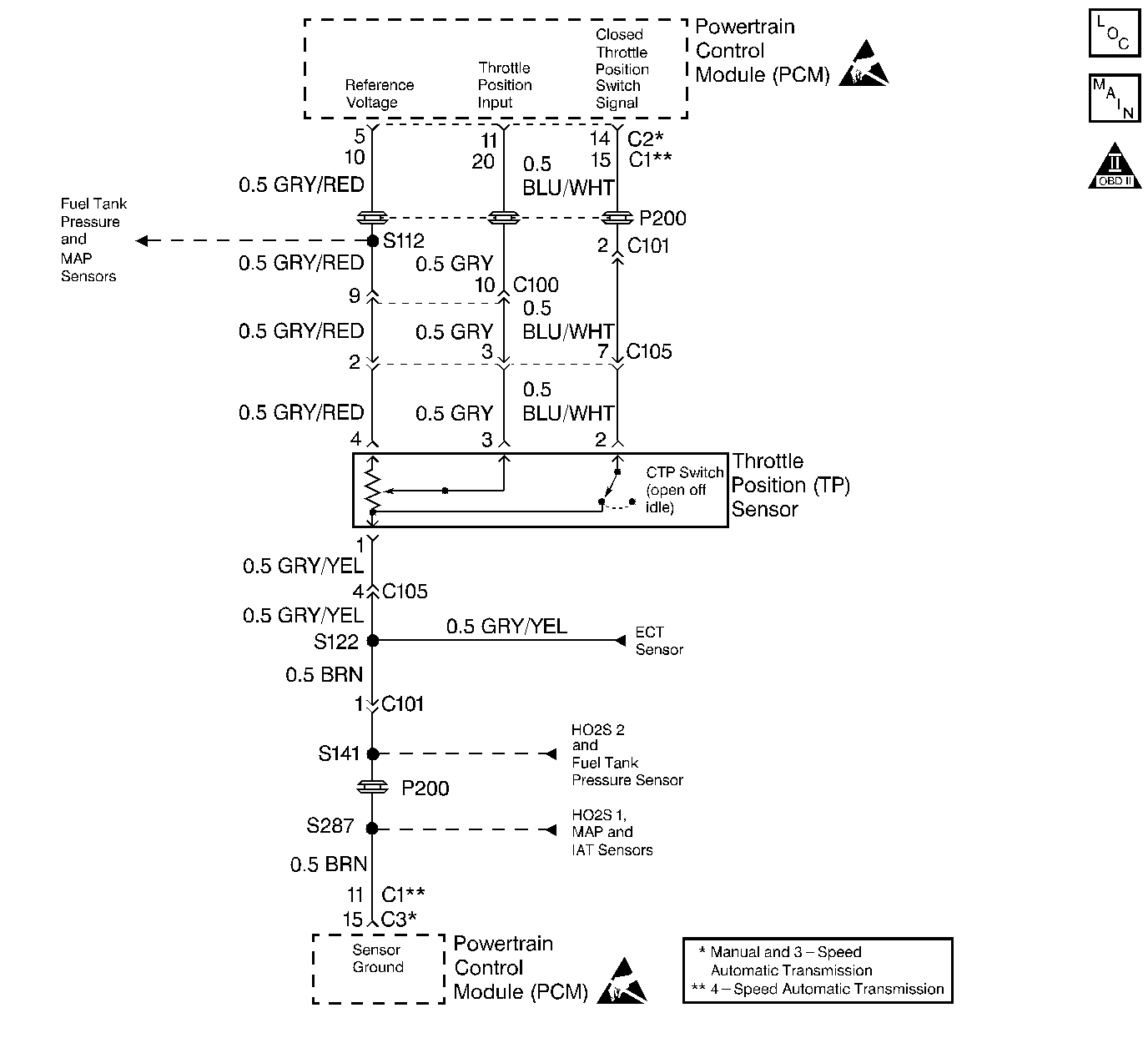
Circuit Description
The Throttle Position (TP) sensor contains a potentiometer whose resistance value changes along with the throttle valve position. The Powertrain Control Module (PCM) provides a 5 volt reference voltage to the TP sensor. The PCM reads the voltage across the TP sensor and converts it into the throttle position. The TP sensor resistance decreases as the throttle valve opening increases. When the TP sensor resistance decreases the voltage being monitored at the PCM will increase. And when the TP sensor resistance increases, because the throttle valve opening is decreasing, the voltage being monitored at the PCM will decrease.
Conditions for Running the DTC
| • | Engine speed is less than 3,500 RPM. |
| • | Maximum flow rate - Minimum flow rate greater than or equal to 25.5 g/s. |
| • | Engine running with MAP sensor less than 26 kPa and throttle valve opening less than 35 degrees. |
| • | Engine running with MAP sensor greater than 67 kPa and throttle valve opening greater than 35 degrees. |
Conditions for Setting the DTC
| • | Difference between expected TP sensor and actual input is greater than a specified value: |
| • | The above conditions are met for at least 3 seconds. |
Action Taken When the DTC Sets
| • | The Malfunction Indicator Lamp (MIL) will illuminate after two consecutive ignition cycles in which the diagnostic runs with the fault active. |
| • | The PCM will record operating conditions at the time the diagnostic fails. This information will be stored in the Freeze Frame buffer. |
Conditions for Clearing the MIL/DTC
| • | The MIL will turn off after three consecutively passing cycles without a fault present. |
| • | A History DTC will clear after 40 consecutive warm-up cycles without a fault. |
| • | DTCs can be cleared by using a scan tool or by disconnecting the PCM battery feed. |
Diagnostic Aids
Check for any of the following conditions:
| • | If a DTC P0122 or P0123 are also set, diagnose those DTCs first. |
| • | A poor connection at the PCM. Inspect the harness connectors for backed out terminal, improper mating, broken locks, improperly formed or damaged terminals, and a poor terminal to wire connection. |
| • | A damaged wiring harness. Inspect the wiring harness for damage. If the harness appears to be OK, observe the TP display on the scan tool while moving connectors and wiring harnesses related to the TP sensor. A change in the TP display will indicate the location of the fault. |
| • | A misadjusted TP sensor or a binding or stuck throttle plate could cause the malfunction to set. Refer to Throttle Position Sensor Adjustment . |
If the DTC P0121 cannot be duplicated, the information included in the Freeze Frame data can be useful in determining vehicle operating conditions when the DTC was first set.
Test Description
The numbers below refer to the step numbers in the Diagnostic Table.
-
The Powertrain OBD System Check prompts the technician to complete some basic checks and store the freeze frame data on the scan tool if applicable. This creates an electronic copy of the data taken when the fault occurred. The information is then stored in the scan tool for later reference.
-
The vehicle must be at operating temperature and a feeler gauge of the specified size must be used.
-
The TP sensor adjustment must be checked and set to specifications. Replace the TP sensor if proper adjustment cannot be made. Refer to Throttle Position Sensor Adjustment .
Step | Action | Value(s) | Yes | No |
|---|---|---|---|---|
Did you perform the Powertrain On-Board Diagnostic (OBD) System Check? | -- | |||
2 |
Is a DTC P0121 set? | -- | Go to Diagnostic Aids | |
3 |
Is the resistance within the specified values? | 3.5k to 6.5k ohms | ||
4 |
Is the resistance within the specified values? | 0.3 to 2.0k ohms | ||
5 |
Is the resistance within the specified values? | 2.0k to 6.5k ohms | ||
Is the resistance within the specified value? | 0 to 500 ohms | |||
7 |
Is the resistance at the specified value? | Infinity | ||
Adjust or replace the TP sensor as necessary. Refer to Throttle Position Sensor Adjustment and Throttle Position Sensor Replacement . Is the action complete? | -- | -- | ||
9 | Replace the PCM. Refer to Powertrain Control Module Replacement . Is the action complete? | -- | -- | |
10 |
Are any DTCs displayed on the scan tool? | -- | Go to the Applicable DTC Table | System OK |
